If you have experience creating Requests for Proposal (RFP) responses, you know every detail matters – from the accurate project timelines to the credibility of the team that will execute the vision.
Central to this credibility is the presentation of employee bios in RFP responses. Unlike traditional resumes, resumes for proposals are tailored overviews, designed to quickly and effectively convey the expertise and experience of key personnel to potential clients.
An effective RFP resume not only demonstrates your firm’s ability to provide a winning solution but also streamlines the decision-making process for evaluators. However, many times, proposal writers think they need to use generic resumes to save time— but this is far from the truth.
In this guide, we’ll teach you how you can craft fast and flawless employee RFP bios that can set your proposal apart, making sure that your team’s strengths stand out from the pile of generic RFP responses.
What Is an RFP Resume?
When organizations issue RFPs, especially for projects that lean heavily on service-based or consulting aspects, they want to know not only the collective capability of the responding firm but also the skills of the people who will lead the work. The reason for this is straightforward: the ultimate quality, efficiency, and success of the project mainly depend on the people leading it.
An RFP resume doesn’t just involve listing someone’s job history. Instead, it’s a detailed look at the work history and skills of key personnel or team members the firm wants to use for the project. While it’s different from a regular job resume, both types still show a person’s qualifications, experiences, skills, and relevant achievements.
A resume in a proposal shows where you’ve worked before, the types of projects you’ve done, and how long you’ve been in that field. It also lists your education, like degrees or special training relevant to the project.
For example, if an RFP is for an architectural project on sustainable design and green building practices, the resume in the RFP response would noticeably highlight experiences, projects, and achievements related to sustainable architecture.
Unrelated details, which might be present in a regular job resume, would be excluded or reduced to maintain focus on the RFP’s specific requirements. This helps the reader to quickly and clearly see the fit between what they need and what the proposed individual offers.
The Importance of Resumes in RFP Responses
Beyond just qualifications, resumes play an important role in building trust between the two parties. By including detailed resumes in the response, firms show transparency, giving the issuer confidence in the abilities of the proposed staff and assuring them that the responding entity is not trying to oversell its capabilities.
Every project carries its unique set of requirements and challenges, and by going through the resumes, issuers can determine if the proposed team has the necessary experience that aligns well with their specific project needs.
This helps the issuer of the RFP identify teams that have faced similar challenges successfully in the past, thus showing potential future success.
How Is a Resume in an RFP Different From a Regular Job Resume?
A resume in an RFP and a regular job resume serve different purposes and audiences, leading to some natural differences in their structure, content, and emphasis.
A regular job resume is typically a broad tool intended for potential employers across a range of opportunities. It provides an overview of an individual’s qualifications, work experience, skills, and achievements, aiming to position the individual as a suitable candidate for various job roles. Its primary goal is to secure interviews or job offers, and thus it’s often crafted with a focus on knowledge and experience, covering multiple aspects of an individual’s career.
On the other hand, a resume in an RFP is a targeted document. Its main purpose is to convince the potential client that the proposed individual (or team) possesses the specific qualifications and experience required for the project outlined in the RFP.
This means that while the basic elements like qualifications and work experience are present, they are tailored and refined to align closely with the requirements and goals stated in the RFP.
Moreover, context becomes important in an RFP resume. While a regular job resume might briefly describe roles and duties in previous positions, an RFP resume would delve deeper into specific projects, their challenges, outcomes, and the individual’s contributions—especially if they mirror the scope of the current RFP.
In simple words, while a regular job resume is about putting oneself in a broad professional light, an RFP resume is a focused document, carefully tailored to resonate with the specific needs and expectations outlined in the RFP.
Can I Use the Same Resume for Multiple RFPs, or Should I Customize It Each Time?
While it’s technically possible to use the same resume for multiple RFPs, it’s not the best practice, especially if you want to increase your chances of success. That’s why customizing the resume for each RFP is highly encouraged.
A tailored resume shows a genuine interest in the project. It signals to the reader that you’ve put time and effort into presenting the most fitting profile for their needs, rather than turning in a generic, one-size-fits-all document. This customization and attention to detail can ensure that your proposal stands out by directly addressing the specific needs and concerns of the issuer.
Additionally, every RFP will have its unique set of requirements, goals, and expectations. What one organization or project prioritizes might be different from another. By tailoring your resume to each specific RFP, you demonstrate a clear understanding of the project’s nuances and requirements.
Moreover, tailoring your RFP resume allows you to emphasize certain outcomes, challenges overcome, or strategies used that are most relevant to the current RFP. This helps you avoid including any irrelevant information that could waste the reader’s time.
While using the same resume for multiple RFPs might save time in the short run, it’s likely to lower the effectiveness of your proposal. Customizing your resume for each RFP not only enhances the relevance of your submission but also demonstrates your commitment and understanding of the project’s specific requirements, making your proposal stand out.
Tips for Writing Resumes for Your RFP Response
Many proposal writers don’t have the time to create winning resumes. However, you can create fast and flawless RFP resumes and stand out from the competition by following these writing tips:
Follow the Requirements of the RFP
Overlooking a small detail can make a significant difference in how your proposal is perceived. Before creating your RFP resume, thoroughly read the RFP to understand its specific requirements. This ensures you address all the key points and criteria the issuer is looking for, increasing your chances of landing the project.
Customize the Employee Resume for Each Proposal
Don’t take a one-size-fits-all approach. Tailor each resume to align with the specific project and its requirements. Highlight relevant experiences, skills, and accomplishments that best match the needs of the RFP. This will make you stand out from the pile of generic RFP responses.
Have a Centralized Place to Store Employee Resumes
Having an organized, centralized location for storing employee resumes can streamline the RFP response process. Using a Digital Asset Management (DAM) system allows for fast access to up-to-date resumes and ensures consistency across responses.
With a DAM, you can make the stress of proposal deadlines easier by having an efficient and reliable system in place that saves you time and reduces potential errors.
| TIP: Looking for more ways a DAM system can benefit your RFP resume process? Read our article on The Benefits of Digital Asset Management (DAM) now. |
Organize Employee Resumes
The profiles you present in your RFP response must reflect the current skills, experiences, and recognition of your employees. Regularly updating these profiles can ensure accuracy and relevancy. For fast and organized retrieval, using a DAM system with a tagging feature can be a game changer.
For example, consider an urgent need to locate the profile of an architect with experience in sustainable design based in New York. With an efficient DAM, you can search using tags such as “sustainable design”, “architect”, and “New York”. This tag-based organization enables a seamless search experience, allowing you to find the right profile in no time.
Tagging can be tailored based on your organization’s needs. Common tags might include type of industry, job roles, years of experience, location, or specific project types. This structure not only ensures that you’re presenting the most recent and relevant information but also guarantees that you can do so quickly and efficiently.
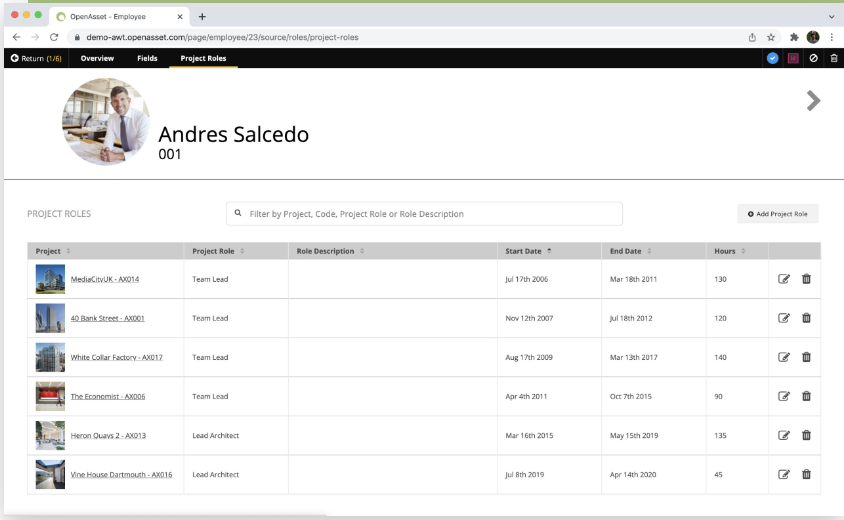
Ensure Employee Bios Are Up-To-Date
Maintaining updated employee RFP bios is more than just reviewing current skills and experiences—it’s also about ensuring that everyone in your team is referencing the most recent and accurate version. With multiple RFPs, project updates, and evolving skill sets, it’s easy for bios to become outdated or varied across different departments.
Version control is essential here. By managing bios within a system that tracks and labels different versions, you can be certain that every team member is pulling from the latest edition. This reduces the risk of showcasing outdated or inconsistent information, which can be harmful in an RFP response.
When everyone is aligned and using the most recent bios, not only is the portrayal of the employee accurate, but it also builds confidence with the reader because it shows your organization is thorough and consistent in its representations.
Include Headshots
People naturally connect with faces, which is why including a headshot alongside an employee’s biography not only humanizes the response but also creates a sense of familiarity and trust.
Beyond the psychological benefits, a well-placed image serves a practical purpose in breaking up lengthy sections of text, making the document more engaging and easier to read.
Using a professional, clear headshot adds a touch of personalization to the RFP response, helping to emphasize the real individuals behind the skills and qualifications.
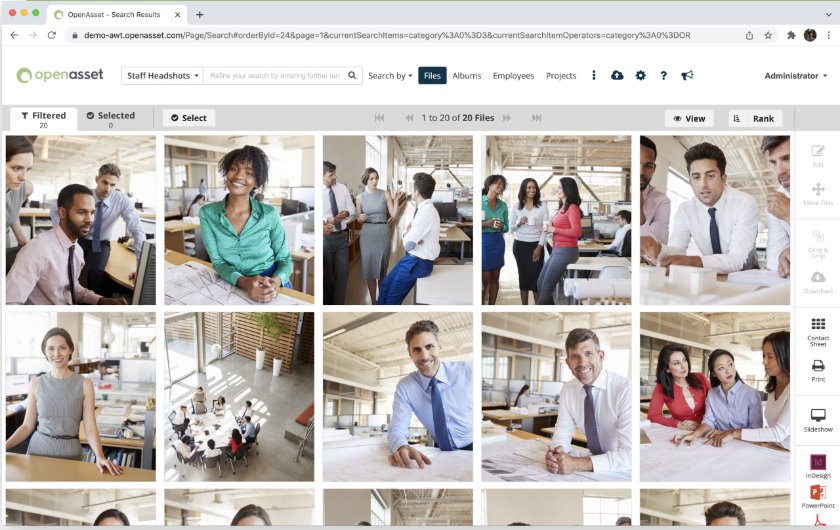
Format Your Resumes
A well-structured and neatly formatted resume is more than just visually appealing – it demonstrates professionalism and attention to detail. Organized layouts help guide the reader’s eye, making it easier for them to find and absorb relevant information.
Consistent use of fonts, colors, bullet points, and spacing ensures clarity and coherence. Furthermore, a unified format across all resumes reinforces a sense of brand consistency and organizational unity.
Always prioritize legibility and simplicity, ensuring that the design enhances the content rather than overshadowing it. A well-formatted resume can make a difference, presenting the information in the best light and making a lasting impression on the RFP reviewer.
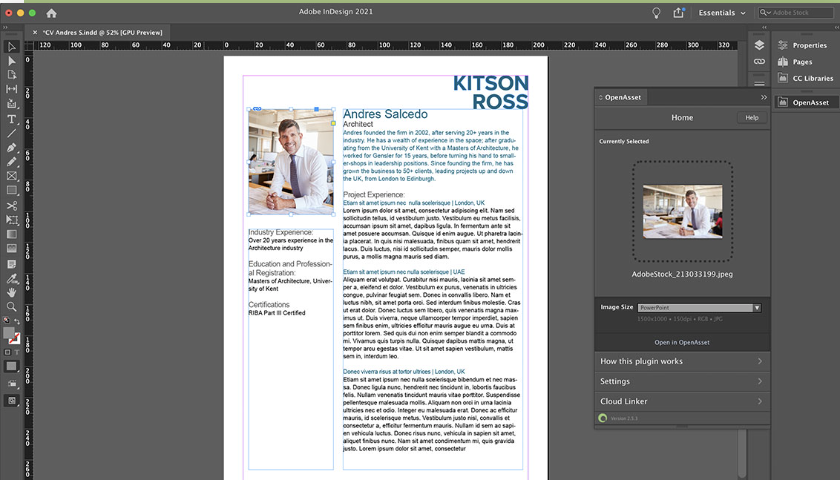
What Are the Elements to Include in a Resume for an RFP?
As mentioned earlier, creating a resume for an RFP differs from a traditional job-seeking resume, and often, proposal writers create resumes without understanding which elements to include. Here are the elements to include in a resume for an RFP:
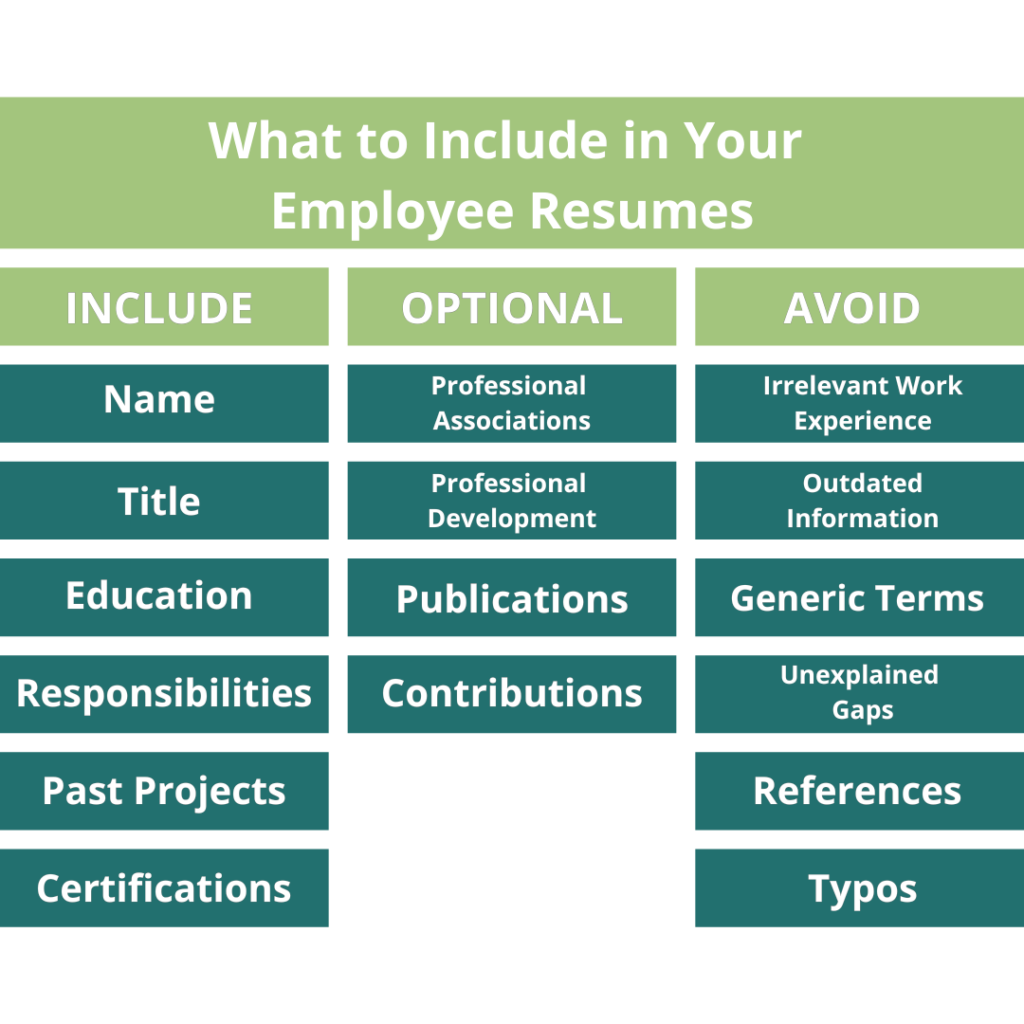
Personal Details
This includes the employee’s full name, title or position, and contact information. While it might not be necessary to include personal addresses, it could be beneficial to list a professional email and phone number for any follow-up or clarifications.
Education
Highlight the academic background, starting with the most recent degree and working backward. Emphasize any degrees that are particularly relevant to the RFP’s requirements.
Experience and Skills
Detail the professional experiences and roles undertaken that are relevant to the project in question. It’s essential to emphasize skills that directly align with the RFP objectives.
Past Projects
Showcase specific projects previously completed, particularly those that mirror or relate closely to the current RFP. Highlight any significant results or positive outcomes from these projects to demonstrate proven expertise.
Certifications and Achievements
Especially in specialized fields, certain certifications can be a testament to an individual’s expertise. List any relevant certifications along with notable achievements in the field that would enhance the proposal’s value.
Optional Elements
Optional elements to consider including in your RFP resume include:
- Professional Associations: Being part of professional organizations or bodies can further validate expertise in a particular area.
- Professional Development: Beyond formal education, highlight any workshops, seminars, or courses attended that enhance your skills and show a commitment to continuous learning.
- Publications or Contributions: If you have written articles, papers, or books, or if you’ve made notable contributions to your field, mention these as evidence of your expertise and thought leadership.
Elements to Avoid in Your Employee Resume
It’s just as important to know what to exclude as it is to know what to include. Here are some elements you might consider avoiding in your RFP employee resume:
- Irrelevant Work Experience: RFP reviewers are typically focused on qualifications that align with their needs, and extra information can take away from the key messages.
- Outdated Information: This includes old certifications that have no place on the current RFP or any other achievements that no longer hold significance.
- Generic terms: Terms like “team player” or “go-getter” can come across as generic and unimpressive. It’s better to demonstrate these traits through examples and achievements.
- Unexplained Gaps: If there are time gaps in the resume, ensure there’s a brief explanation.
- References: Unless specifically asked for in the RFP, it’s common to leave out references and instead note that they’re available upon request. This will also help you keep it short.
- Errors and Typos: Having errors and typos can reflect poorly on attention to detail.
Writing Employee Resumes That Win Business
Now that we’ve taken a look at what elements to include and what elements to avoid, let’s take a look at key points that will help you win new business through your RFP resumes.
Decide Who Will Write the Resume
Choosing the right person to write an employee resume can make a world of difference in how effectively it portrays skills and experience. A cost-effective method would be to have the proposed candidate prepare the first draft of the resume.
However, whether it’s an in-house expert familiar with the project’s complexities, a dedicated proposal writer, or the employees themselves, make sure the writer understands the stakes and can condense complex achievements into compelling stories.
Conduct Interviews With Key Personnel
The heart of any compelling employee resume lies in its authentic portrayal of accomplishments and expertise. By interviewing key personnel, you can capture the essence of their professional journey, gain insights into specific projects they’ve succeeded in, and understand their unique selling points.
This firsthand information serves as the foundation upon which the resume is built, ensuring it is both accurate and engaging.
Pick Your Tone
The tone of a resume is a subtle yet powerful tool that can set the mood for readers. While professionalism is important, consider whether a more formal or conversational tone aligns with the brand and the intended audience. A startup may appreciate a modern, relaxed tone, whereas a government entity might lean toward more traditional phrasing.
Ensure your choice resonates with the potential client’s expectations and culture.
Don’t Sound Arrogant
Speaking of tone, another important factor is to not come off as arrogant in the RFP resume. Go for a balance where achievements are communicated with pride, but without sounding arrogant.
Being too confident can push away those reviewing the RFP, making them doubt the truth of what’s being said and if a collaboration is possible. Speaking with genuine confidence, without bragging, comes off better as it shows your worth and that you can work well with others.
Make Sure to Proofread
We touched on this earlier when discussing errors and typos as something to avoid. Proofreading will help you get rid of any mistakes you didn’t catch the first time.
No matter how well-crafted, a resume with typos or grammatical errors can weaken its credibility. Before submission, have multiple eyes review the document.
Leveraging tools, peers, or even professional proofreading services can ensure that your resume is polished, error-free, and presents the best possible impression to RFP evaluators.
Get Approval From the Employee
Before finalizing and submitting an employee resume as part of an RFP response, you must obtain approval from the employee mentioned. Their feedback can not only highlight any overlooked achievements or qualifications but can also help in fact-checking and making sure the accuracy of the details mentioned.
Make a Personal Connection
Beyond the listing of qualifications and professional milestones, the human element of a resume can set it apart. Including personal touches, such as hobbies, interests, or fun facts about the employee, can make the resume more relatable and memorable to RFP evaluators.
This not only paints a fuller picture of the employee but also fosters a sense of connection. It subtly communicates that behind every project or skill mentioned, there’s a real person with passions, aspirations, and a personality that they bring to the table.
Keep It Concise and Focus on Key Points
In RFP responses, every word counts. While you may be tempted to present an in-depth resume of an employee’s career, the key is to strike a balance between thoroughness and conciseness.
Prioritize including important elements that make you stand out, such as employment history, training, standout skills, notable accomplishments, and any unique factors that differentiate you from the crowd.
Be Authentic
When creating an employee resume, you must present an honest description of your qualifications, skills, and experiences. Exaggerating achievements or misrepresenting information might seem like a short-term strategy to gain an advantage, but the consequences of getting caught can be harmful to you and your firm’s reputation.
Create a Template
Having a clear format and design in place means you won’t miss any important details and everything will look unified, while also presenting a consistent brand image. A template streamlines the process for faster turnaround times without having to give up on quality.
While customization for individual resumes is key, starting with a well-thought-out template can simplify the task and enhance the overall presentation.
| TIP: Want to create winning resumes for individuals or whole teams with minimal effort? With formatted InDesign templates, you can generate employee resumes at the click of a button. Learn how to Create Employee Resume Documents at Speed Using OpenAsset now. |
Faster RFP responses: Save time on employee resumes
The secret to creating faster RFP responses? A robust DAM. Here’s how a DAM can help you generate employee resumes in minutes:
Store and Manage Employee Profiles in a DAM
A DAM makes creating tailored RFP resumes faster and more efficient. How exactly? Look for a DAM with an Employee Module. This will allow you to store, find, and use all the digital assets you have associated with individual team members.
The Employee Module will allow you to manage employee-related data directly in the DAM through customizable data fields. This gives you the flexibility to store any relevant data within the DAM without a complicated configuration process.
You can also connect employee data such as role and time worked, to projects. Retrieve this information effortlessly and integrate both the project data and visuals into employee resumes.
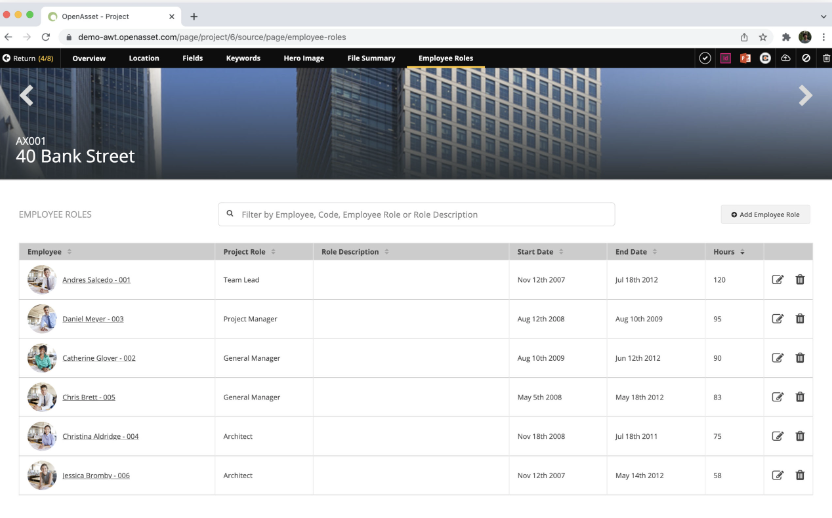
Use Tags
Categorizing employee-related assets with tags can help you quickly find and retrieve profiles based on specific skills, expertise, or other criteria. This helps in matching the right candidate with the project’s requirements quickly.
Synchronize Employee Data With Your CRM or ERP
The Employee Module also promotes organizational efficiency by automating the creation of resume documents and letting you automatically sync employee data between the DAM and your CRM or ERP system.
Seamless synchronization between OpenAsset and your CRM or ERP system means you always work with the latest employee data. This reduces data management errors and inconsistencies and speeds up the RFP response process.
Leverage AI Tools
AI in DAM saves you time and resources in managing your images through AI-suggested keywords, image similarity search, AI content assist, and more. These features:
- Reduce the time it takes to manually tag images
- Helps you build and expand taxonomies
- Gives you additional images to select from and use.
- Enables you to leverage Generative AI for project descriptions and employee RFP bios
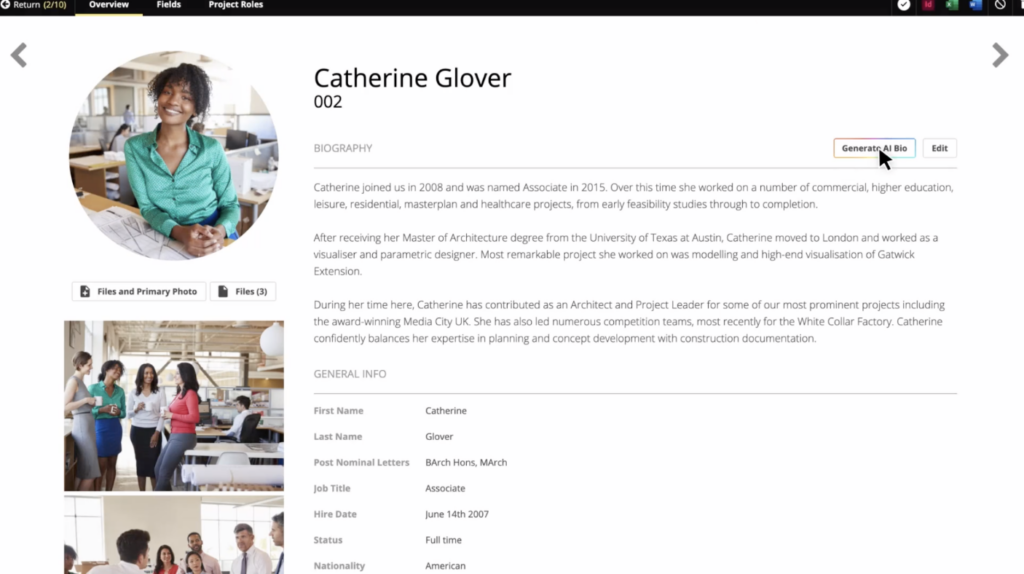
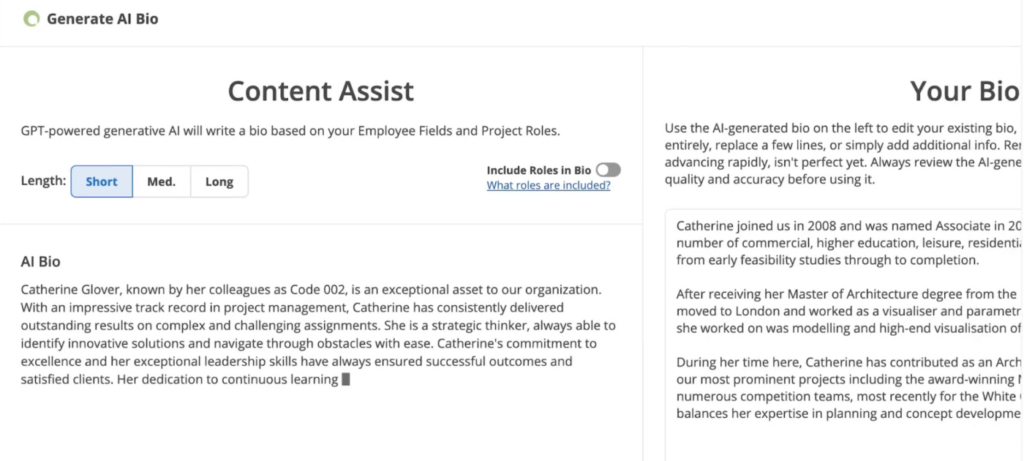
| TIP: Looking for more ways to ensure your AEC proposal stands out from the rest of the pile? Learn How to Write a Proposal Cover Page and How to Write a Proposal Cover Letter now. |
Examples of Employee Resumes in RFPs
Now that you know everything there is to know about creating fast and flawless resumes in RFPs, let’s take a look at what that (and examples of employee bios) looks like in a DAM like OpenAsset.
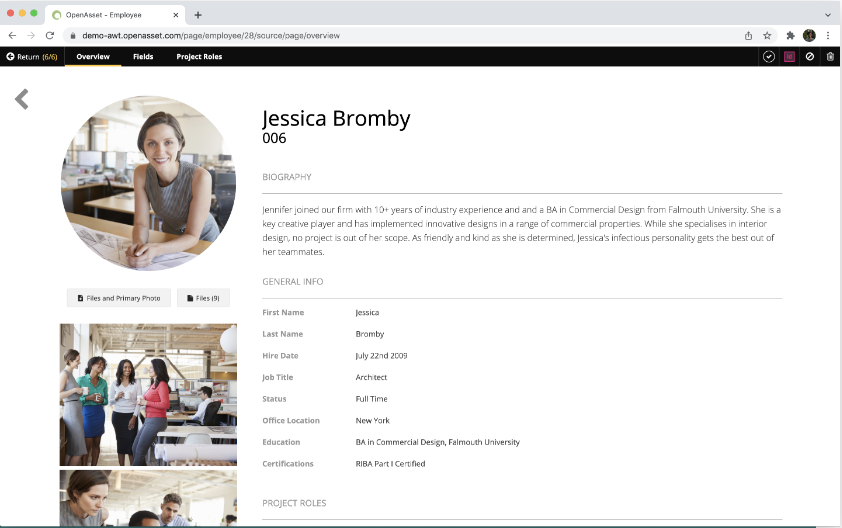
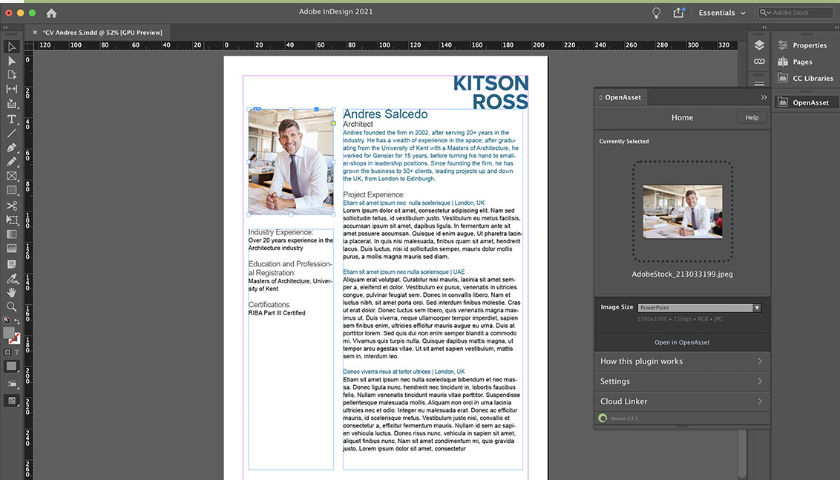
Save Time Creating Resumes in RFPs
Cut down on the hours spent creating resumes for RFPs by using OpenAsset and the Employee Module. It enhances productivity within your organization by automating the generation of resume documents.
Furthermore, it provides a seamless integration that allows for automatic synchronization of employee data between OpenAsset and your CRM or ERP system.
Whether you’re pulling from previous templates or starting from scratch, OpenAsset simplifies and enhances the task, letting you focus on what matters— winning the proposal.
Ready to start creating efficient, impactful RFP resumes?



